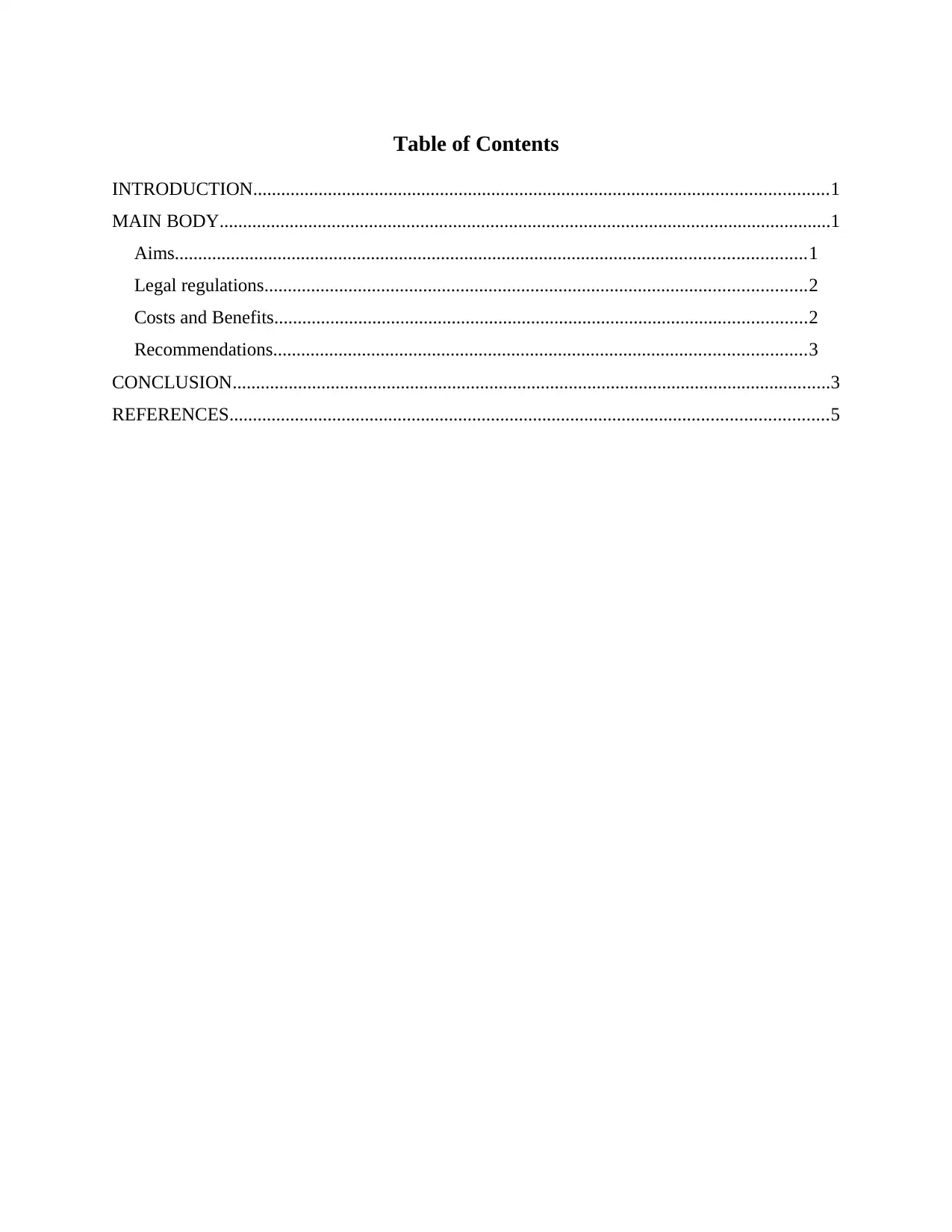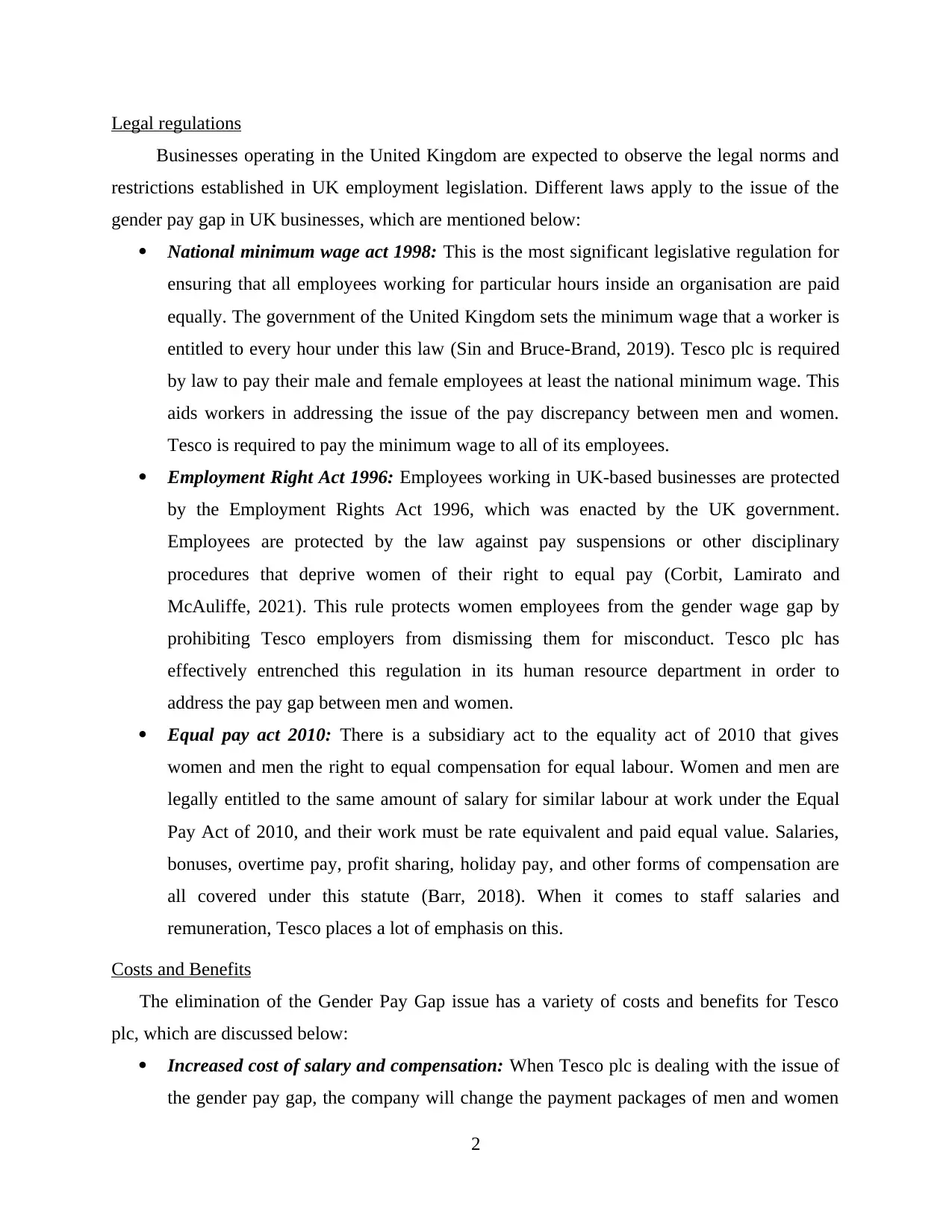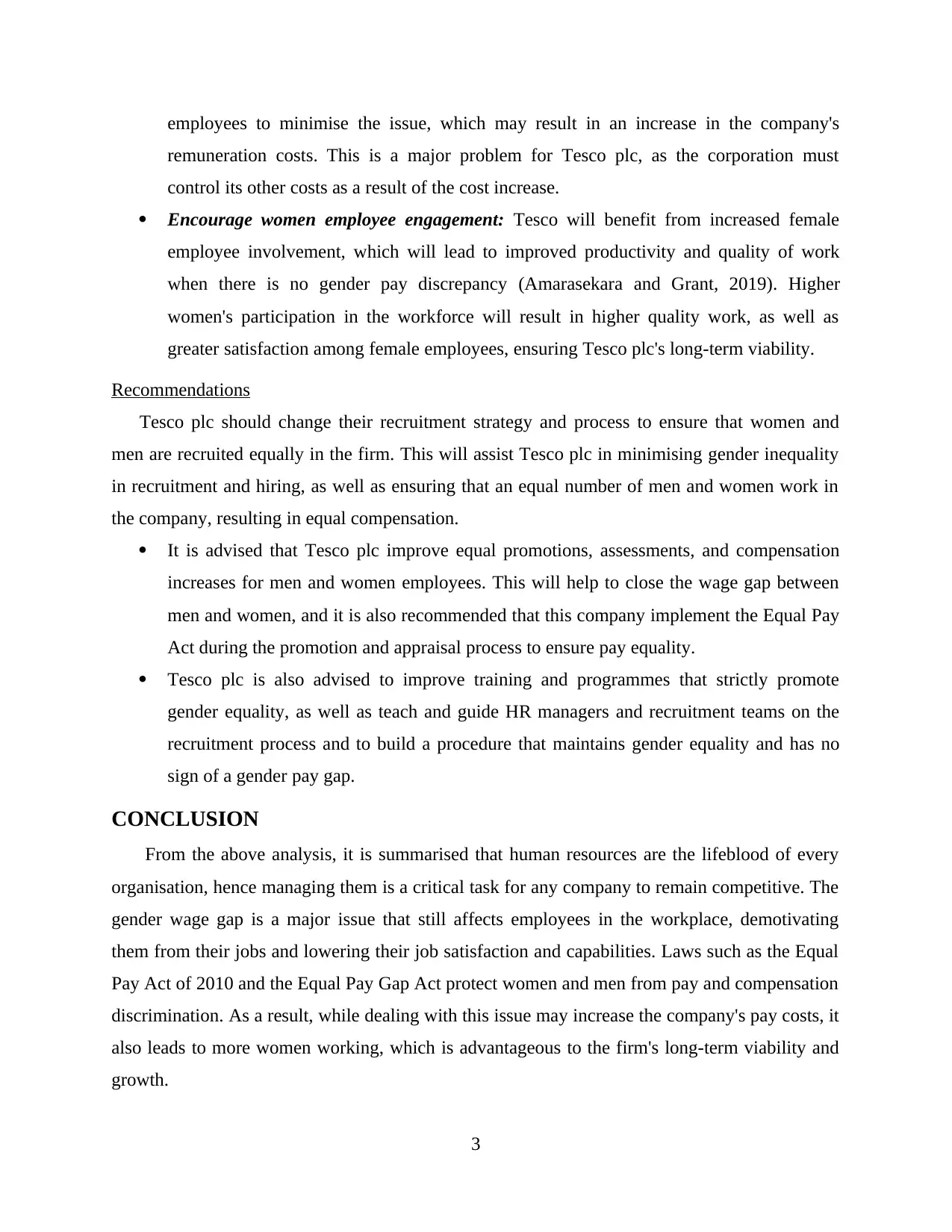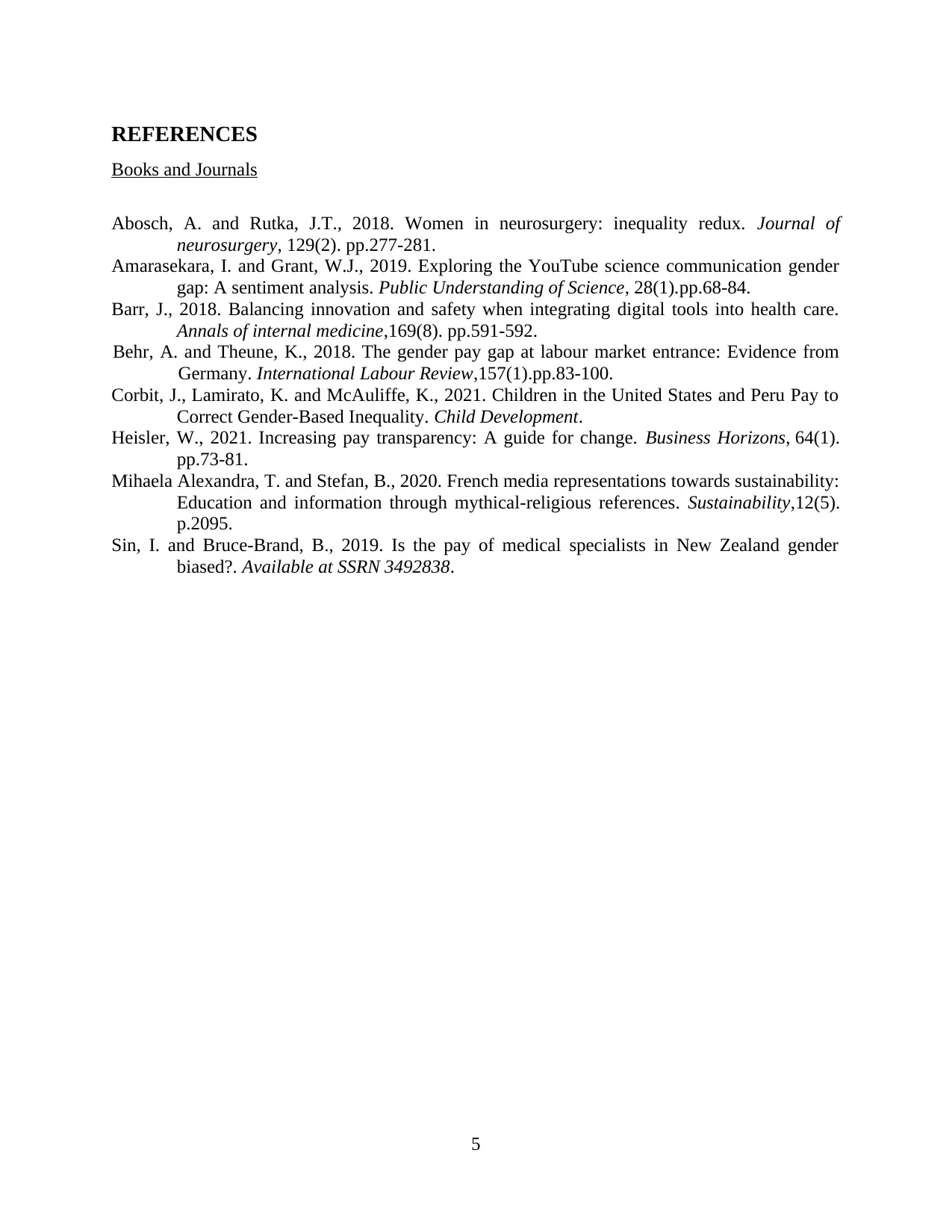Introduction to HRM: Gender Pay Gap Analysis at Tesco plc (UWL)
VerifiedAdded on 2023/06/14
|7
|1516
|177
Report
AI Summary
This report examines Tesco plc's approach to the gender pay gap, focusing on the company's aims, legal regulatory requirements, costs, and benefits. It highlights Tesco's aims to create workforce diversity and reduce gender inequality through sustainable development. The report refers to the National Minimum Wage Act 1998, the Employment Rights Act 1996, and the Equal Pay Act 2010 as key legal frameworks guiding Tesco's efforts. It discusses the increased costs of salary adjustments and the benefits of increased female employee engagement. Recommendations include changes to recruitment strategies, improvements to promotion and compensation practices, and enhanced training programs promoting gender equality. The analysis concludes that while addressing the gender pay gap may increase costs, it ultimately contributes to long-term viability and growth through improved employee satisfaction and productivity. Desklib provides access to similar solved assignments and study resources for students.

Introduction to HR
Paraphrase This Document
Need a fresh take? Get an instant paraphrase of this document with our AI Paraphraser

Table of Contents
INTRODUCTION...........................................................................................................................1
MAIN BODY...................................................................................................................................1
Aims.......................................................................................................................................1
Legal regulations....................................................................................................................2
Costs and Benefits..................................................................................................................2
Recommendations..................................................................................................................3
CONCLUSION................................................................................................................................3
REFERENCES................................................................................................................................5
INTRODUCTION...........................................................................................................................1
MAIN BODY...................................................................................................................................1
Aims.......................................................................................................................................1
Legal regulations....................................................................................................................2
Costs and Benefits..................................................................................................................2
Recommendations..................................................................................................................3
CONCLUSION................................................................................................................................3
REFERENCES................................................................................................................................5

INTRODUCTION
Businesses rely exclusively on the human resources they hire in today's competitive business
environment. However, when it comes to human resource management, the company faces a
variety of obstacles and issues, including the gender pay gap, employee engagement, talent
management, and zero-hour contracts, among others (Behr and Theune, 2018). The current paper
will examine the topic of the gender wage gap by focusing on Tesco plc, the UK's largest retailer.
The largest British supermarket is a worldwide corporation with a vast workforce to run its
operations all over the world. Because of its diverse product line, the corporation has several
activities. The report will include the goals, regulatory requirements, as well as the costs and
benefits of Tesco's efforts to address the gender pay gap.
MAIN BODY
Aims
The term "Gender Pay Gap" refers to the disparity in salary between men and women
working in the same organisation or industry. Women are often paid less than men in society and
in the corporate sphere. Education, occupation, working hours, experience, and a variety of other
factors are all significant causes of the gender wage gap within an organisation.
To create diversity in workforce: When it comes to the issue of the gender pay gap,
Tesco plc's major goal is to improve the company's high degree of diversity (Mihaela
Alexandra and Stefan, 2020). Tesco believes that in order to lift the standard in terms of
efficiency, thinking creativity, and, most crucially, long-term growth, diversity is critical.
When equal men and women work in the retail industry, the variety of the staff will
create efficiency, creativity, emotional intelligence, and profitability in the organisation,
allowing it to persuade its clients.
To reduce gender inequality: Gender discrimination is widespread in the UK retail
industry. Tesco seeks to minimise gender disparity by changing its business model and
focusing on sustainable development (Heisler, 2021). The organisation aims to minimise
gender inequality in every business aspect by enhancing women's salaries, hiring women
from the ground level to the top level, and increasing advancement opportunities.
1
Businesses rely exclusively on the human resources they hire in today's competitive business
environment. However, when it comes to human resource management, the company faces a
variety of obstacles and issues, including the gender pay gap, employee engagement, talent
management, and zero-hour contracts, among others (Behr and Theune, 2018). The current paper
will examine the topic of the gender wage gap by focusing on Tesco plc, the UK's largest retailer.
The largest British supermarket is a worldwide corporation with a vast workforce to run its
operations all over the world. Because of its diverse product line, the corporation has several
activities. The report will include the goals, regulatory requirements, as well as the costs and
benefits of Tesco's efforts to address the gender pay gap.
MAIN BODY
Aims
The term "Gender Pay Gap" refers to the disparity in salary between men and women
working in the same organisation or industry. Women are often paid less than men in society and
in the corporate sphere. Education, occupation, working hours, experience, and a variety of other
factors are all significant causes of the gender wage gap within an organisation.
To create diversity in workforce: When it comes to the issue of the gender pay gap,
Tesco plc's major goal is to improve the company's high degree of diversity (Mihaela
Alexandra and Stefan, 2020). Tesco believes that in order to lift the standard in terms of
efficiency, thinking creativity, and, most crucially, long-term growth, diversity is critical.
When equal men and women work in the retail industry, the variety of the staff will
create efficiency, creativity, emotional intelligence, and profitability in the organisation,
allowing it to persuade its clients.
To reduce gender inequality: Gender discrimination is widespread in the UK retail
industry. Tesco seeks to minimise gender disparity by changing its business model and
focusing on sustainable development (Heisler, 2021). The organisation aims to minimise
gender inequality in every business aspect by enhancing women's salaries, hiring women
from the ground level to the top level, and increasing advancement opportunities.
1
⊘ This is a preview!⊘
Do you want full access?
Subscribe today to unlock all pages.

Trusted by 1+ million students worldwide

Legal regulations
Businesses operating in the United Kingdom are expected to observe the legal norms and
restrictions established in UK employment legislation. Different laws apply to the issue of the
gender pay gap in UK businesses, which are mentioned below:
National minimum wage act 1998: This is the most significant legislative regulation for
ensuring that all employees working for particular hours inside an organisation are paid
equally. The government of the United Kingdom sets the minimum wage that a worker is
entitled to every hour under this law (Sin and Bruce-Brand, 2019). Tesco plc is required
by law to pay their male and female employees at least the national minimum wage. This
aids workers in addressing the issue of the pay discrepancy between men and women.
Tesco is required to pay the minimum wage to all of its employees.
Employment Right Act 1996: Employees working in UK-based businesses are protected
by the Employment Rights Act 1996, which was enacted by the UK government.
Employees are protected by the law against pay suspensions or other disciplinary
procedures that deprive women of their right to equal pay (Corbit, Lamirato and
McAuliffe, 2021). This rule protects women employees from the gender wage gap by
prohibiting Tesco employers from dismissing them for misconduct. Tesco plc has
effectively entrenched this regulation in its human resource department in order to
address the pay gap between men and women.
Equal pay act 2010: There is a subsidiary act to the equality act of 2010 that gives
women and men the right to equal compensation for equal labour. Women and men are
legally entitled to the same amount of salary for similar labour at work under the Equal
Pay Act of 2010, and their work must be rate equivalent and paid equal value. Salaries,
bonuses, overtime pay, profit sharing, holiday pay, and other forms of compensation are
all covered under this statute (Barr, 2018). When it comes to staff salaries and
remuneration, Tesco places a lot of emphasis on this.
Costs and Benefits
The elimination of the Gender Pay Gap issue has a variety of costs and benefits for Tesco
plc, which are discussed below:
Increased cost of salary and compensation: When Tesco plc is dealing with the issue of
the gender pay gap, the company will change the payment packages of men and women
2
Businesses operating in the United Kingdom are expected to observe the legal norms and
restrictions established in UK employment legislation. Different laws apply to the issue of the
gender pay gap in UK businesses, which are mentioned below:
National minimum wage act 1998: This is the most significant legislative regulation for
ensuring that all employees working for particular hours inside an organisation are paid
equally. The government of the United Kingdom sets the minimum wage that a worker is
entitled to every hour under this law (Sin and Bruce-Brand, 2019). Tesco plc is required
by law to pay their male and female employees at least the national minimum wage. This
aids workers in addressing the issue of the pay discrepancy between men and women.
Tesco is required to pay the minimum wage to all of its employees.
Employment Right Act 1996: Employees working in UK-based businesses are protected
by the Employment Rights Act 1996, which was enacted by the UK government.
Employees are protected by the law against pay suspensions or other disciplinary
procedures that deprive women of their right to equal pay (Corbit, Lamirato and
McAuliffe, 2021). This rule protects women employees from the gender wage gap by
prohibiting Tesco employers from dismissing them for misconduct. Tesco plc has
effectively entrenched this regulation in its human resource department in order to
address the pay gap between men and women.
Equal pay act 2010: There is a subsidiary act to the equality act of 2010 that gives
women and men the right to equal compensation for equal labour. Women and men are
legally entitled to the same amount of salary for similar labour at work under the Equal
Pay Act of 2010, and their work must be rate equivalent and paid equal value. Salaries,
bonuses, overtime pay, profit sharing, holiday pay, and other forms of compensation are
all covered under this statute (Barr, 2018). When it comes to staff salaries and
remuneration, Tesco places a lot of emphasis on this.
Costs and Benefits
The elimination of the Gender Pay Gap issue has a variety of costs and benefits for Tesco
plc, which are discussed below:
Increased cost of salary and compensation: When Tesco plc is dealing with the issue of
the gender pay gap, the company will change the payment packages of men and women
2
Paraphrase This Document
Need a fresh take? Get an instant paraphrase of this document with our AI Paraphraser

employees to minimise the issue, which may result in an increase in the company's
remuneration costs. This is a major problem for Tesco plc, as the corporation must
control its other costs as a result of the cost increase.
Encourage women employee engagement: Tesco will benefit from increased female
employee involvement, which will lead to improved productivity and quality of work
when there is no gender pay discrepancy (Amarasekara and Grant, 2019). Higher
women's participation in the workforce will result in higher quality work, as well as
greater satisfaction among female employees, ensuring Tesco plc's long-term viability.
Recommendations
Tesco plc should change their recruitment strategy and process to ensure that women and
men are recruited equally in the firm. This will assist Tesco plc in minimising gender inequality
in recruitment and hiring, as well as ensuring that an equal number of men and women work in
the company, resulting in equal compensation.
It is advised that Tesco plc improve equal promotions, assessments, and compensation
increases for men and women employees. This will help to close the wage gap between
men and women, and it is also recommended that this company implement the Equal Pay
Act during the promotion and appraisal process to ensure pay equality.
Tesco plc is also advised to improve training and programmes that strictly promote
gender equality, as well as teach and guide HR managers and recruitment teams on the
recruitment process and to build a procedure that maintains gender equality and has no
sign of a gender pay gap.
CONCLUSION
From the above analysis, it is summarised that human resources are the lifeblood of every
organisation, hence managing them is a critical task for any company to remain competitive. The
gender wage gap is a major issue that still affects employees in the workplace, demotivating
them from their jobs and lowering their job satisfaction and capabilities. Laws such as the Equal
Pay Act of 2010 and the Equal Pay Gap Act protect women and men from pay and compensation
discrimination. As a result, while dealing with this issue may increase the company's pay costs, it
also leads to more women working, which is advantageous to the firm's long-term viability and
growth.
3
remuneration costs. This is a major problem for Tesco plc, as the corporation must
control its other costs as a result of the cost increase.
Encourage women employee engagement: Tesco will benefit from increased female
employee involvement, which will lead to improved productivity and quality of work
when there is no gender pay discrepancy (Amarasekara and Grant, 2019). Higher
women's participation in the workforce will result in higher quality work, as well as
greater satisfaction among female employees, ensuring Tesco plc's long-term viability.
Recommendations
Tesco plc should change their recruitment strategy and process to ensure that women and
men are recruited equally in the firm. This will assist Tesco plc in minimising gender inequality
in recruitment and hiring, as well as ensuring that an equal number of men and women work in
the company, resulting in equal compensation.
It is advised that Tesco plc improve equal promotions, assessments, and compensation
increases for men and women employees. This will help to close the wage gap between
men and women, and it is also recommended that this company implement the Equal Pay
Act during the promotion and appraisal process to ensure pay equality.
Tesco plc is also advised to improve training and programmes that strictly promote
gender equality, as well as teach and guide HR managers and recruitment teams on the
recruitment process and to build a procedure that maintains gender equality and has no
sign of a gender pay gap.
CONCLUSION
From the above analysis, it is summarised that human resources are the lifeblood of every
organisation, hence managing them is a critical task for any company to remain competitive. The
gender wage gap is a major issue that still affects employees in the workplace, demotivating
them from their jobs and lowering their job satisfaction and capabilities. Laws such as the Equal
Pay Act of 2010 and the Equal Pay Gap Act protect women and men from pay and compensation
discrimination. As a result, while dealing with this issue may increase the company's pay costs, it
also leads to more women working, which is advantageous to the firm's long-term viability and
growth.
3

4
⊘ This is a preview!⊘
Do you want full access?
Subscribe today to unlock all pages.

Trusted by 1+ million students worldwide

REFERENCES
Books and Journals
Abosch, A. and Rutka, J.T., 2018. Women in neurosurgery: inequality redux. Journal of
neurosurgery, 129(2). pp.277-281.
Amarasekara, I. and Grant, W.J., 2019. Exploring the YouTube science communication gender
gap: A sentiment analysis. Public Understanding of Science, 28(1).pp.68-84.
Barr, J., 2018. Balancing innovation and safety when integrating digital tools into health care.
Annals of internal medicine,169(8). pp.591-592.
Behr, A. and Theune, K., 2018. The gender pay gap at labour market entrance: Evidence from
Germany. International Labour Review,157(1).pp.83-100.
Corbit, J., Lamirato, K. and McAuliffe, K., 2021. Children in the United States and Peru Pay to
Correct Gender‐Based Inequality. Child Development.
Heisler, W., 2021. Increasing pay transparency: A guide for change. Business Horizons, 64(1).
pp.73-81.
Mihaela Alexandra, T. and Stefan, B., 2020. French media representations towards sustainability:
Education and information through mythical-religious references. Sustainability,12(5).
p.2095.
Sin, I. and Bruce-Brand, B., 2019. Is the pay of medical specialists in New Zealand gender
biased?. Available at SSRN 3492838.
5
Books and Journals
Abosch, A. and Rutka, J.T., 2018. Women in neurosurgery: inequality redux. Journal of
neurosurgery, 129(2). pp.277-281.
Amarasekara, I. and Grant, W.J., 2019. Exploring the YouTube science communication gender
gap: A sentiment analysis. Public Understanding of Science, 28(1).pp.68-84.
Barr, J., 2018. Balancing innovation and safety when integrating digital tools into health care.
Annals of internal medicine,169(8). pp.591-592.
Behr, A. and Theune, K., 2018. The gender pay gap at labour market entrance: Evidence from
Germany. International Labour Review,157(1).pp.83-100.
Corbit, J., Lamirato, K. and McAuliffe, K., 2021. Children in the United States and Peru Pay to
Correct Gender‐Based Inequality. Child Development.
Heisler, W., 2021. Increasing pay transparency: A guide for change. Business Horizons, 64(1).
pp.73-81.
Mihaela Alexandra, T. and Stefan, B., 2020. French media representations towards sustainability:
Education and information through mythical-religious references. Sustainability,12(5).
p.2095.
Sin, I. and Bruce-Brand, B., 2019. Is the pay of medical specialists in New Zealand gender
biased?. Available at SSRN 3492838.
5
1 out of 7
Related Documents
Your All-in-One AI-Powered Toolkit for Academic Success.
+13062052269
info@desklib.com
Available 24*7 on WhatsApp / Email
![[object Object]](/_next/static/media/star-bottom.7253800d.svg)
Unlock your academic potential
Copyright © 2020–2025 A2Z Services. All Rights Reserved. Developed and managed by ZUCOL.





